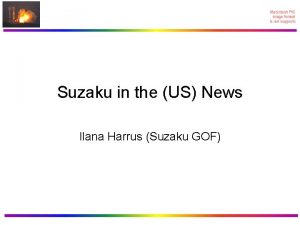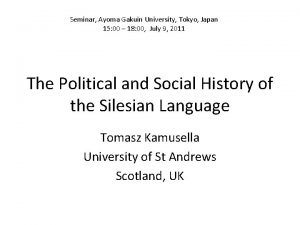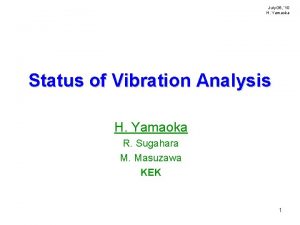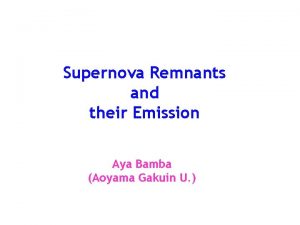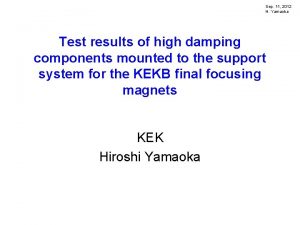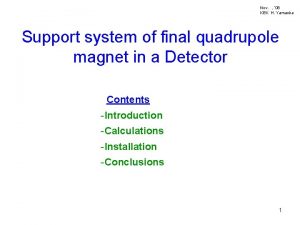The Suzaku mission Kazutaka Yamaoka Aoyama Gakuin University

































- Slides: 33

The Suzaku mission Kazutaka Yamaoka Aoyama Gakuin University On behalf of the Suzaku team

Outline of my talk u Suzaku overview : instruments and current status u Early results from PV phase • Galactic X-ray binaries, AGNs, … u Suzaku wide-band all-sky monitor (WAM) • GRB prompt emissions

Suzaku launch u u u Fifth Japanese-US X-ray satellite Launched by M-V rocket on July 10, 2005 Astro-E 2 Suzaku (朱雀) “red Chinese phoenix” u LEO 570 km, 31 deg.

Suzaku instruments. X-ray CCD X-ray Telescopes XRT GSFC ISAS Nagoya Camera XIS MIT Osaka Kyoto ISAS X-ray Calorimeter XRS Hard X-ray Detector HXD GSFC ISAS TMU Tokyo ISAS RIKEN

Current Status of Suzaku 2005 July 10 th Launch of Astro-E 2 2005 Aug. 8 th XRS accident 7 e. V@6 ke. V at 60 m. K 2005 Aug. 12 th First light of XIS (E 0102 -72) 2005 Aug. 19 th First light of HXD (Cen A) 2005 Sep. 1 st Start of PV observations (SWG) ~ 70 sources 2006 Apr. 1 st Start of GO observations (AO 1) ~ 2007 Mar. AO 2 (the proposal due date will be Dec. 2006)

XRT+X-ray CCD(XIS) XIS: 3 FI chips + 1 BI chip u u u Large effective area around the iron band Good line-response in the soft X-rays Low background XMM Suzaku BI Chandra Suzaku FI

Hard X-ray Detector (HXD) Well-type GSO/BGO phoswich detectors + Si PIN diodes with 2 mm thickness u Narrow field of view 0. 5°× 0. 5°<100 ke. V u Thorough active shielding surrounded with BGO u First Japanese hard X-ray instrument u

HXD background rejection u Power of active shielding HXD-GSO

HXD background level u The lowest background is achieved. The sensitivity depends on modeling of the background. Current: 5% accuracy ~ 0. 5 m. Crab in 10 -40 ke. V u Crab RXTE Beppo-SAX/PDS Suzaku/HXD Background study is still in progress Our Goal: 1% ~ 0. 1 m. Crab level GSO PIN Energy (ke. V)

Key science of Suzaku u Wide-band spectroscopy 0. 2 -600 ke. V • Variable Galactic and extragalactic sources • Unidentified IGR sources and Ge. V/Te. V sources “provide exactly simultaneous data” u u Study of x-ray emissions for diffuse sources Plasma diagnostics with high energy resolution Search for the hard X-ray tail Connections between thermal and non-thermal universe

Suzaku performance (I) - X-ray response Iron-Kα S XV Kβ center Si XIV Kα Si XIII Kβ S XV Kα S XVI Kα Si XIII Kα u Galactic ASCA 320 ksec (Koyama et al. 1996) Iron-Kβ, Ni-Kα Chandra 600 ksec (Muno et al. 2004) Suzaku 180 kec Preliminary! Koyama et al. XMM 50 ksec (Tanaka)

Suzaku performance - Wide-band spectroscopy u Spectral study for weak sources (a few m. Crab) Preliminary! Cen A “HXD first light !” Watanabe et al.

Cyclotron resonance features in the magnetized neutron stars u Her X-1 and transient pulsar A 0535+262 Preliminary! ~ 37 ke. V ~ 46 ke. V Terada, Mihara et al.

Galactic black hole binaries u u Low/hard state of Cyg. X-1 and GROJ 1655 -40 Study of corona, disk and reflected material Ratio to wabs 0. 5* PL(Γ=1. 6) Each 20 ksec soft excess narrow Fe (6. 4 ke. V) 0. 5— 350 ke. V Cutoff (Te=110 ke. V) Kubota, Takahashi et al. Preliminary!

Microquasar GRS 1915+105 (I) u Large multi-wavelength Campaign on Oct. 18 -19 INTEGRAL, Swift, RXTE Spitzer, ESO-NTT XIS (1 -12 ke. V) VLA, Ryle etc. . u Oscillation state PIN (10 -40 ke. V) Ueda et al.

Microquasar GRS 1915+105(II) u Study of hard X-ray behavior in the state variations Absorption-line changes with intensity variations. Oscillation High H-like iron-K Stable Oscillation Low Preliminary! Ueda et al.

MCG 6 -30 -15 u u Broad-iron line associated with absorption lines confirmed Less variable in hard X-rays XIS Preliminary! Fabian et al.

Wide-band study of AGNs u Study of reflection and high energy cutoff in the AGNs CXB synthesis Preliminary! NGC 2110 Ecut>150 ke. V No reflection? Okajima et al. MCG 5 -23 -16 Reeves et al.

Radio galaxy 3 C 120 Suzaku compared to Beppo. SAX 1 10 Beppo SAX (160 ksec) Zdziarski & Grandi, 2001 100 Kataoka et al. Good S/N Preliminary! Suzaku (150 ksec)

Wide-band All-sky Monitor (WAM) u Second function of HXD lateral shield e. x. Beppo-SAX GRBM, INTEGRAL SPI-ACS n n Large effective area 400 cm 2 @1 Me. V Wide field of view Ideal GRB detectors !

GRB light curves u u 83 GRB candidates per 8 months WAM detection rate: ~ 120/year short/long bimodal distribution short Preliminary! long WAM 0. 2 s 30 s

WAM energy spectra Me. V emissions were detected from some GRBs ! Study of Me. V emission GRB 051008 GRB 060213 GRB 060317 Me. V emission !

WAM + Swift/BAT spectra u u Suzaku/WAM 50 -5000 ke. V Swift/BAT 15 -150 ke. V Broadband coverage 15 -5000 ke. V Suitable for study of prompt emissions GRB 051008 GRB 051111 GRB 050915 B

High red-shift GRB 050904 u u Most distant z=6. 29 T 90: 212 s WAM Ep=201 (-43, +84) ke. V Preliminary! WAM BAT

Short hard GRB 051221 A u u z = 0. 54 T 90: 0. 22 s Ep=378 (-120, +285) ke. V WAM BAT Preliminary!

Amati relation in the WAM-GRBs 7 GRBs z GRB 050904 6. 29 GRB 051109 A 2. 346 GRB 051111 1. 55 GRB 051221 0. 54 GRB 060210 3. 91 GRB 060223 A 4. 41 GRB 060502 A 1. 51 Preliminary!

IPN localizations WAM joined the 3 rd Interplanetary Network since Jan. 2006 u Localize the short/hard burst as fast as possible follow-up with Swift/XRT or optical telescopes Konus-WAM u GRB 060213 GRB 060303 GRB 060317 GRB 060425 GRB 060429 GRB 060522 GRB 060610 Konus-SPI-ACS Konus-MO GRB 060610

Summary u The X-ray satellite Suzaku is now operating well with two instruments (XIS and HXD) ★Power of “Suzaku” u u Wide-band coverage Soft X-ray response and very low background WAM as a monitor of GRB prompt emissions cf. Suzaku pointing afterglow study The exciting results will be presented at the Suzaku conference in Kyoto on Dec. 2006.

Suzaku conference u Kyoto, Japan u Dec. 4 -8, 2006

Te. V SNR RXJ 1713 -3946 HXD Narrow FOV First Detection up to 40 ke. V Preliminary! XIS 0 HXD-PIN XIS Takahashi, Tanaka et al. HXD 47. 8 ksec 40 ke. V

Compton thick AGNs u NGC 4945 Griffith, Isobe, Itoh et al.

Epeak Distributions Number of events -WAM results -normalized BATSE results Ep (log)

HXD Expected Sensitivity 3 x 10 -11 erg/s/cm 2 (10 -100 ke. V) 3 x 10 -12 Continuum Sensitivity d. E/E = 0. 5 Exp. = 100 ks 3 sigma stat. 1 and 3 % of BGD ・ 10 -30 ke. V, 3 sigma photon limit for 100 ks : 0. 1 m. Crab ・ 10 -30 ke. V, 2% of BGD : 0. 1 m. Crab The better modeling of backgrond will allow fainter source, 0. 1— 0. 2 m. Crab at 10— 40 ke. V.
 Temple university mission statement
Temple university mission statement Her campus mission statement
Her campus mission statement Mygrants columbia
Mygrants columbia Columbia university mission statement
Columbia university mission statement Slu 4 core values
Slu 4 core values Hình ảnh bộ gõ cơ thể búng tay
Hình ảnh bộ gõ cơ thể búng tay Bổ thể
Bổ thể Tỉ lệ cơ thể trẻ em
Tỉ lệ cơ thể trẻ em Gấu đi như thế nào
Gấu đi như thế nào Glasgow thang điểm
Glasgow thang điểm Bài hát chúa yêu trần thế alleluia
Bài hát chúa yêu trần thế alleluia Môn thể thao bắt đầu bằng chữ đua
Môn thể thao bắt đầu bằng chữ đua Thế nào là hệ số cao nhất
Thế nào là hệ số cao nhất Các châu lục và đại dương trên thế giới
Các châu lục và đại dương trên thế giới Công thức tính thế năng
Công thức tính thế năng Trời xanh đây là của chúng ta thể thơ
Trời xanh đây là của chúng ta thể thơ Cách giải mật thư tọa độ
Cách giải mật thư tọa độ 101012 bằng
101012 bằng Phản ứng thế ankan
Phản ứng thế ankan Các châu lục và đại dương trên thế giới
Các châu lục và đại dương trên thế giới Thơ thất ngôn tứ tuyệt đường luật
Thơ thất ngôn tứ tuyệt đường luật Quá trình desamine hóa có thể tạo ra
Quá trình desamine hóa có thể tạo ra Một số thể thơ truyền thống
Một số thể thơ truyền thống Bàn tay mà dây bẩn
Bàn tay mà dây bẩn Vẽ hình chiếu vuông góc của vật thể sau
Vẽ hình chiếu vuông góc của vật thể sau Nguyên nhân của sự mỏi cơ sinh 8
Nguyên nhân của sự mỏi cơ sinh 8 đặc điểm cơ thể của người tối cổ
đặc điểm cơ thể của người tối cổ Thế nào là giọng cùng tên?
Thế nào là giọng cùng tên? Vẽ hình chiếu đứng bằng cạnh của vật thể
Vẽ hình chiếu đứng bằng cạnh của vật thể Tia chieu sa te
Tia chieu sa te Thẻ vin
Thẻ vin đại từ thay thế
đại từ thay thế điện thế nghỉ
điện thế nghỉ





































